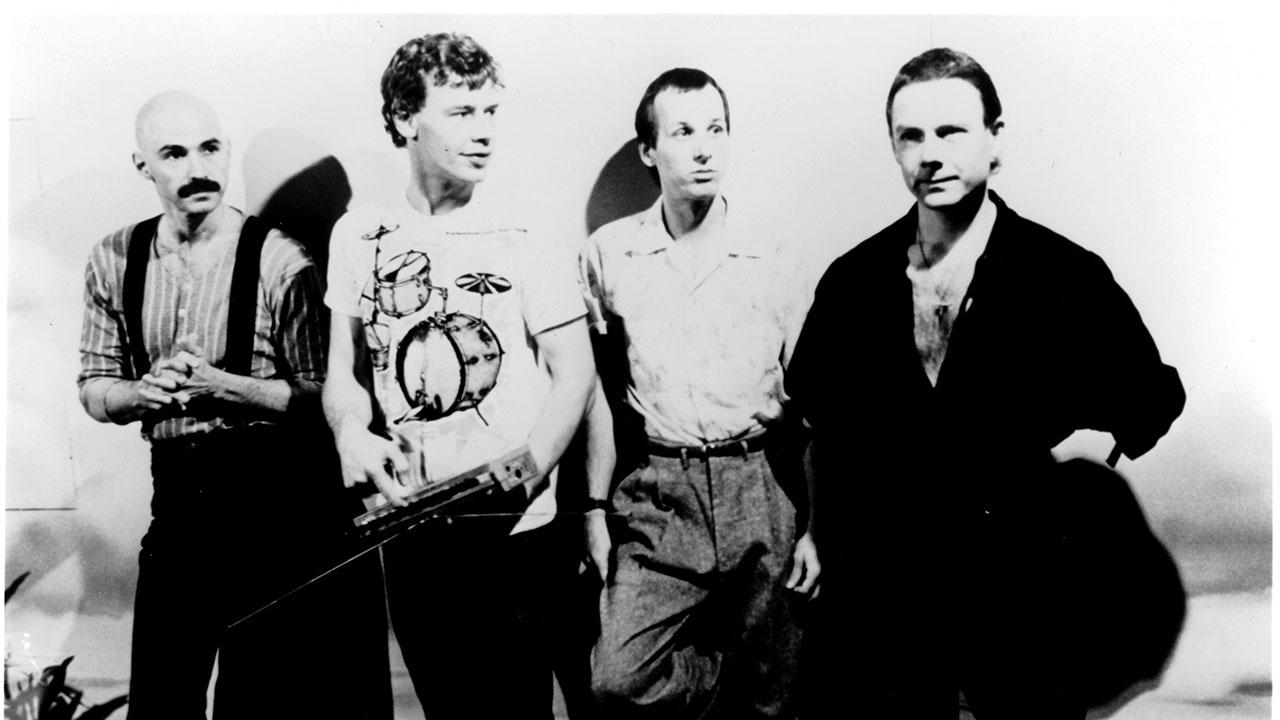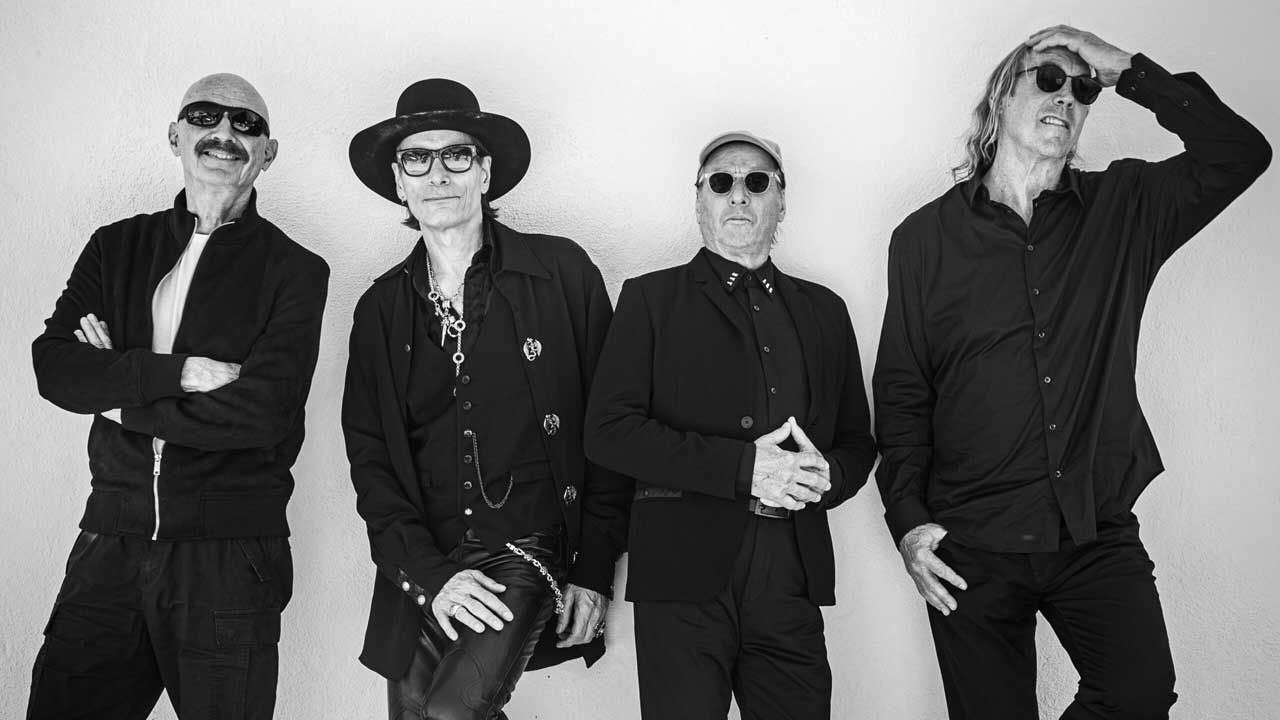Ten cool King Crimson songs from the 80s
Having shocked fans and band members alike by folding the band in 1974, Robert Fripp surprised everyone in 1981 by reactivating King Crimson with a new-look line-up

King Crimson’s arrival in 1981 took a lot of people by surprise. The band, which had split in 1974, after Robert Fripp had declared the band to be “completely over for ever and ever” had not only returned with drummer Bill Bruford but with two Americans: legendary session bassist Tony Levin and Zappa/Bowie guitarist/vocalist, Adrian Belew. Harnessing the newly available technology of the day including Roland Guitar Synths, Chapman Stick, and Simmons electronic drum kit, this new band was a Mellotron-free zone deploying curious textures, polyrhythmic grooves, and interlocking guitars. The quartet released Discipline (1981), Beat (1982), and Three Of A Perfect Pair (1984), becoming the first lineup to record three consecutive studio albums in the band’s turbulent history. During their time together they fashioned their own distinctive musical vocabulary and in the process, completely reinvented and re-energised King Crimson for the 1980s. Here are ten of their very best moments.
King Crimson - Matte Kudasai (1981)
With its loping country and western-style lilt, this touching ballad began life when Fripp was living in New York in 1977 working on ideas for Exposure and was further developed by Belew during rehearsals in Dorset in 1981. The title was taken from a Japanese phrase book by Belew and means “please wait for me.” Fripp describes Belew’s slide playing here as “superlative” in a slow-moving song that winsomely watches the world go by.
King Crimson - Three Of A Perfect Pair (1984)
Having struggled and ultimately failed to get an album together during 1983, Crimson started again from scratch the following year and only just made it. Belew’s song features a dysfunctional couple locked in a strangely dependent relationship. Who could he possibly be talking about? Although on the surface things sail smoothly along, the subtext is that all is not well in the Crimson camp. Highpoints include an acidic cut-up—style solo from Belew and Tony Levin’s agile bass stalking around the chords. A showcase for Belew’s needle-sharp picking, he would later go on to perform this song as a solo spot on KC’s tours in 2000.
King Crimson - Neal And Jack And Me (1982)
Fripp, who had been reading the works of beat generation writer Jack Kerouac, was inspired to pass Belew a slip of paper on which he’d written, ’I’m wheels, I’m moving the wheels’ and in doing so provide Belew with a vehicle to write a scrambling piece about life on the road and the ache of homesickness, a theme echoed again on Waiting Man from elsewhere on the album. With their cyclical riffing moving with the speed and elan of a finely tuned engine, the resolution in the final third of the song is a wonderful confluence between Belew’s yearning vocals and Fripp’s soaring guitar. Oh, and full marks for literary references to Bill Bruford whose subtle percussion mimics the keys of a typewriter.
King Crimson - The Sheltering Sky (1981)
Initially stemming from a group improvisation, the piece features Bruford playing an African slit an ancient instrument that stands in stark contrast to the hi-tech equipment that surrounds it. With both guitarists using the Roland GR300 guitar synth, the range of available timbres, pitches, and sounds was considerably extended. Here, Fripp offers up something akin to a trumpet, drifting over the languid, heat-haze rhythm and the deep seam of Levin’s Stick bass. Tape loops of Belew’s wordless vocal harmonies are gradually added into the mix, appearing like mirages in the distance. Enigmatic and beguiling, it’s a truly inspired piece of Crimsoneering.
King Crimson - Requiem (1982)
The stormy sounds of this wholly improvised track, with its howling guitars vying for dominance against squalling clouds of explosive drumming and slow-burning bass, mirrors the serious falling out Belew and Fripp experienced during its mixing. With Belew finally demanding Fripp leave the studio, which he duly did, it looked for a while as though the band had all but died - hence the title. Nevertheless, the dynamic tension and cathartic releases make this a powerful moment in the Crimson canon.
King Crimson - Sleepless (1984)
It was Tony Levin’s bass that got King Crimson out of the doldrums in a rehearsal in Bearsville, Woodstock that was going nowhere. Doubled in a slapback echo, it provides the quickening pulse of the song. Bruford recalls he and Belew shared accommodation during the writing with the guitarist suffering from bouts of insomnia. “Adrian maintained that the house was haunted and that he was having some very strange dreams but you do when you’re up against a deadline and you’ve got lyrics to write. Adrian earned every penny for those words.” Even more bizarrely perhaps, a 12-inch dance mix was released and however unlikely it sounds, became a minor hit in London’s dance clubs at the time.
Sign up below to get the latest from Prog, plus exclusive special offers, direct to your inbox!
King Crimson - Neurotica (1982)
Back in 1969 on King Crimson’s first visit to the Big Apple, they responded by writing Pictures Of A City. A decade or so later, they were at it again. Originally entitled Manhattan and developed while on tour in 1981, in this musical evocation of New York’s hurly burly, the quartet recreates traffic jams, snarling street scenes, and a surreal bestiary in the city that never sleeps with their own kind of mutant be-bop and gawky rock. Part hyper-rap, part tour guide barker, Belew’s astonishing 100-miles-a-minute delivery completes the sensation of traveling through New York’s red-eyed chaos at breakneck speed.
KIng Crimson - Discipline (1981)
As Bill Bruford famously said, “King Crimson were the only band in the world who could play in 17/8 time and stay at 5-star hotels.” While not directly referring to this track it’s probably close enough. An interlocking jigsaw revolving around Fripp and Belew’s weaving guitars, Bruford’s percolating rhythms, and Levin’s springing bass line, it forms the musical blueprint for the group that got together in the spring of 1981. Tumbling grooves build with an intensity that occasionally teeters on the brink of breaking apart. This performance is from 1984 and the final gig by the 80s quartet.
King Crimson - Elephant Talk (1981)
Starting with the undulating riff from Tony Levin’s Chapman Stick, this track sounded like a decisive break with the past, serving notice that this King Crimson was like nothing else that had gone before it. Belew’s declamatory vocal style drew comparisons with Talking Heads’ David Byrne, with whom Belew had recently been touring, and his fretboard-coaxed roars, simulating animalistic agitation, would be a defining characteristic of 80s Crimson. The track marks the very first time on a King Crimson record where somebody other than Robert Fripp is taking a lead guitar solo.
King Crimson - Frame By Frame (1981)
While clearly influenced by the systems music of composer Steve Reich and Javanese Gamelan, this pointillistic style hadn’t just arrived out of the blue. It can be traced back to Fripp’s solo album, God Save The Queen/Under Heavy Manners and in several of the pieces performed during 1980 with his group, The League Of Gentlemen. Arguably the premier showcase of this twin-guitar Crimson, Belew maintains the repetitive figure with Fripp relocating the accent at a different point with each cycle, creating a tension that slowly stretches the piece apart. As the lines slowly unravel, spiraling in a decaying orbit, Fripp comes in with the fiery burst of dazzlingly fast double-time picking. In concert, when the track ended, Fripp was often seen blowing on his poor old smoking fingertips.
Sid's feature articles and reviews have appeared in numerous publications including Prog, Classic Rock, Record Collector, Q, Mojo and Uncut. A full-time freelance writer with hundreds of sleevenotes and essays for both indie and major record labels to his credit, his book, In The Court Of King Crimson, an acclaimed biography of King Crimson, was substantially revised and expanded in 2019 to coincide with the band’s 50th Anniversary. Alongside appearances on radio and TV, he has lectured on jazz and progressive music in the UK and Europe.
A resident of Whitley Bay in north-east England, he spends far too much time posting photographs of LPs he's listening to on Twitter and Facebook.











